Archive for the ‘Ricardo Miranda Zuniga’ tag
NEGOCIO at Centro Cultural Las Cigarreras de Alicante
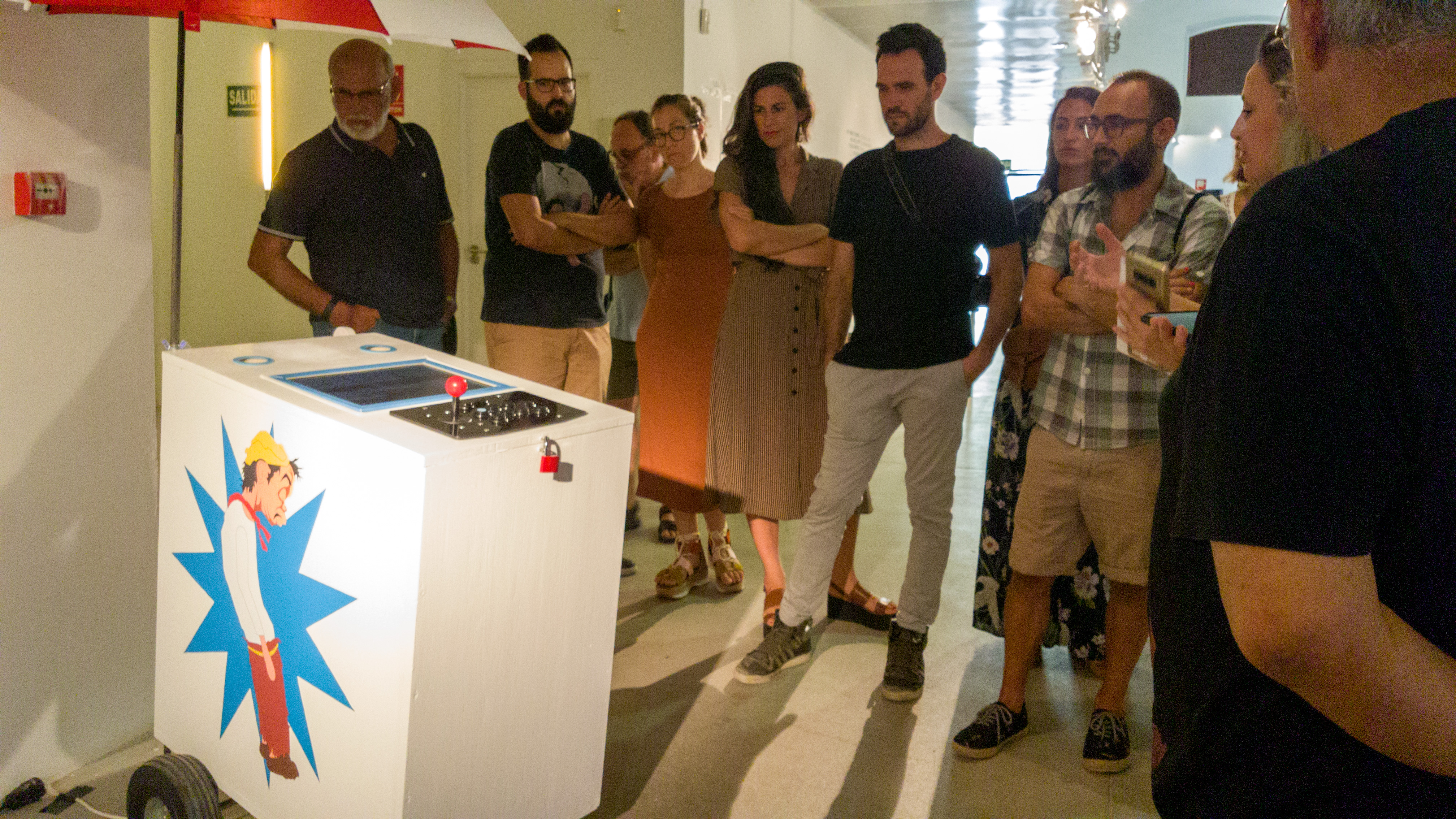
NEGOCIO at el Centro Cultural Las Cigarreras de Alicante is an ambitious attempt to present an archive of the creation of games as art largely over the last twenty years, though one work – “White Chess” by Yoko Ono dates back to 1966. The majority of works have been created in the 21st century. The exhibition presents a mix of digital and analog games and the vast majority of the exhibition is interactive – allowing visitors to play the games on exhibit as intended by the artists.
I’ve been honored with the inclusion of VAGAMUNDO: A Migrant’s Tale (2002) included the exhibition (pictured above). This is a sculpture and video game originally presented on the street that unfortunately is as timely today as 16 years ago due to the Trump administration’s stance regarding immigration.
The curators – David Machado Gutierrez, Alba Garcia Martinez, Beatriz Martinez-Villagrasa and Miguel Soria Andurell state:
The origin of the game, is lost in the memory of time; the game is perhaps as old as the very existence of the human being on earth. But what does the game transmit to us today apart from its playful appearance? Can art use it as a tool that reflects on challenges and social reality? Does it also work as an act of criticism? This exhibition does not pretend not to answer these questions, since it would be too ambitious, but it is formulated so that the spectator participates and, using the works of art as a guide. The exhibition investigates in the multiple planes what may unfolds in games as art.
Below are a selection of photographs documenting the exhibition.
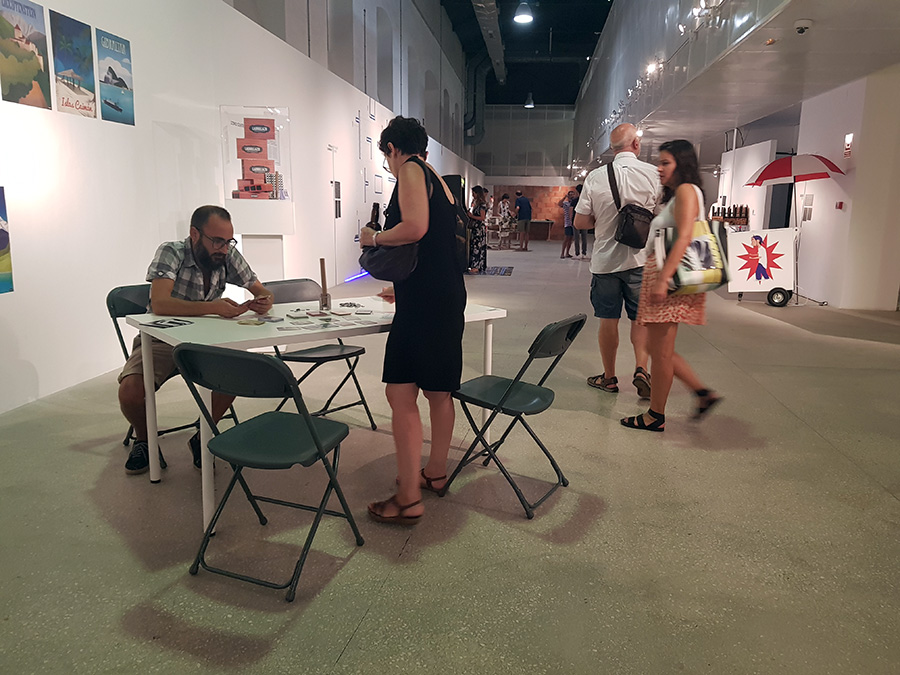
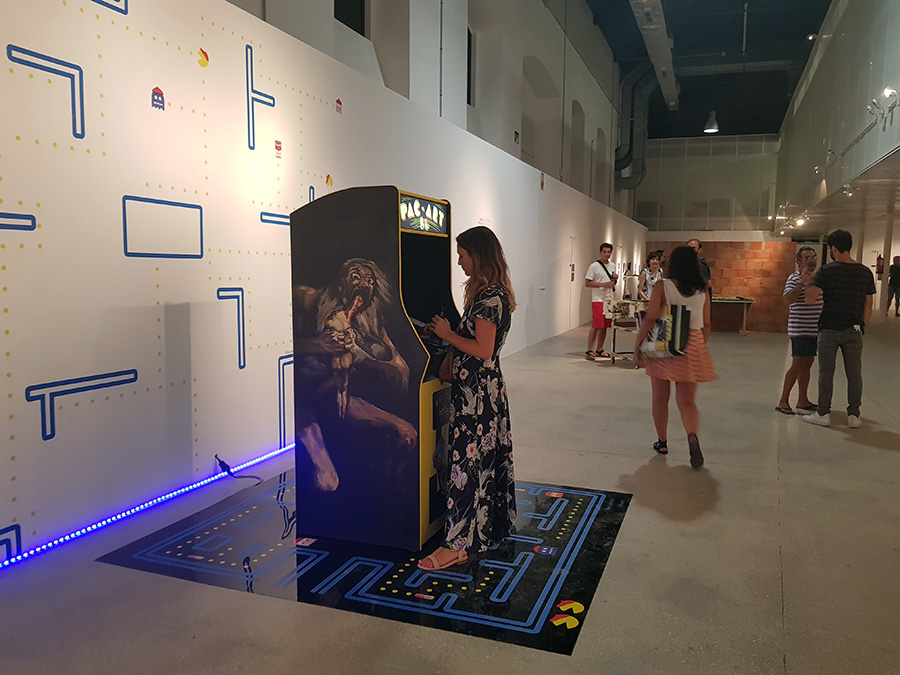
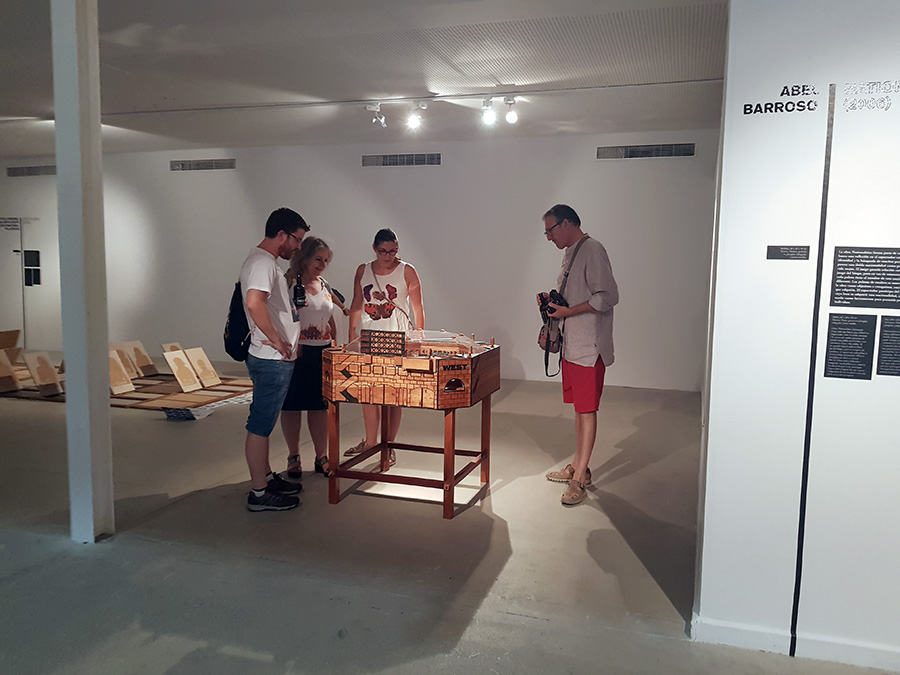
Two game sculptures by Cuban artist Abel Barroso
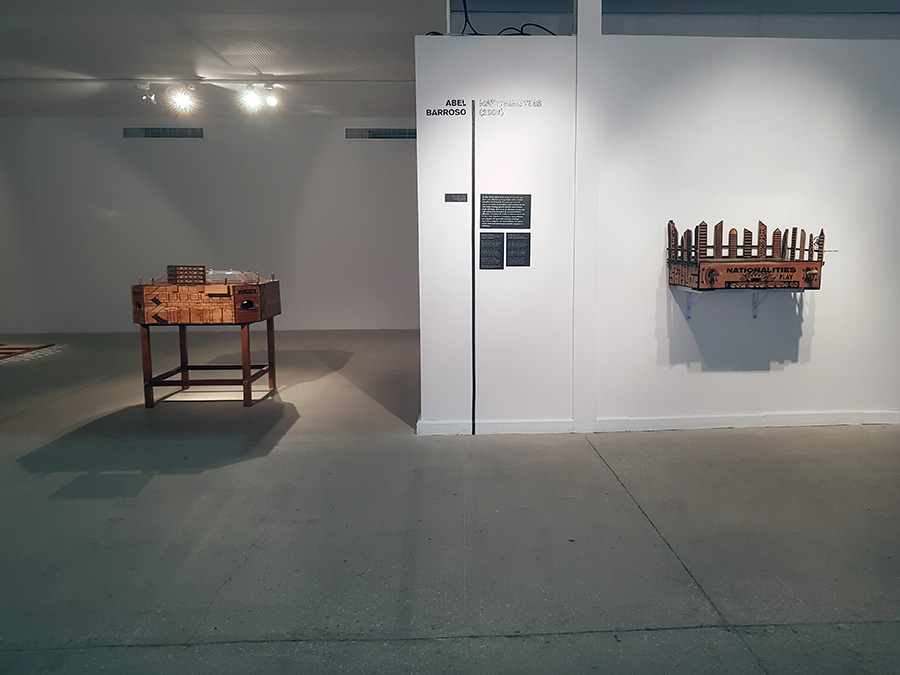
Carlos No’s Intifada – a “ping-pong table which, in place of a net, has been divided into two halves by a very high brick wall, topped by barbed wire that heightens a feeling of insurmountabilty. There arises in the spectator the curiosity of seeing the other side, the place which one is forbidden to see and be in, as if one had discovered Lewis Carrol’s charade in the passage to the other side of the looking-glass. In this wonderland that comprises this side and the other side, both the space and the visitor’s steps are divided into two.”
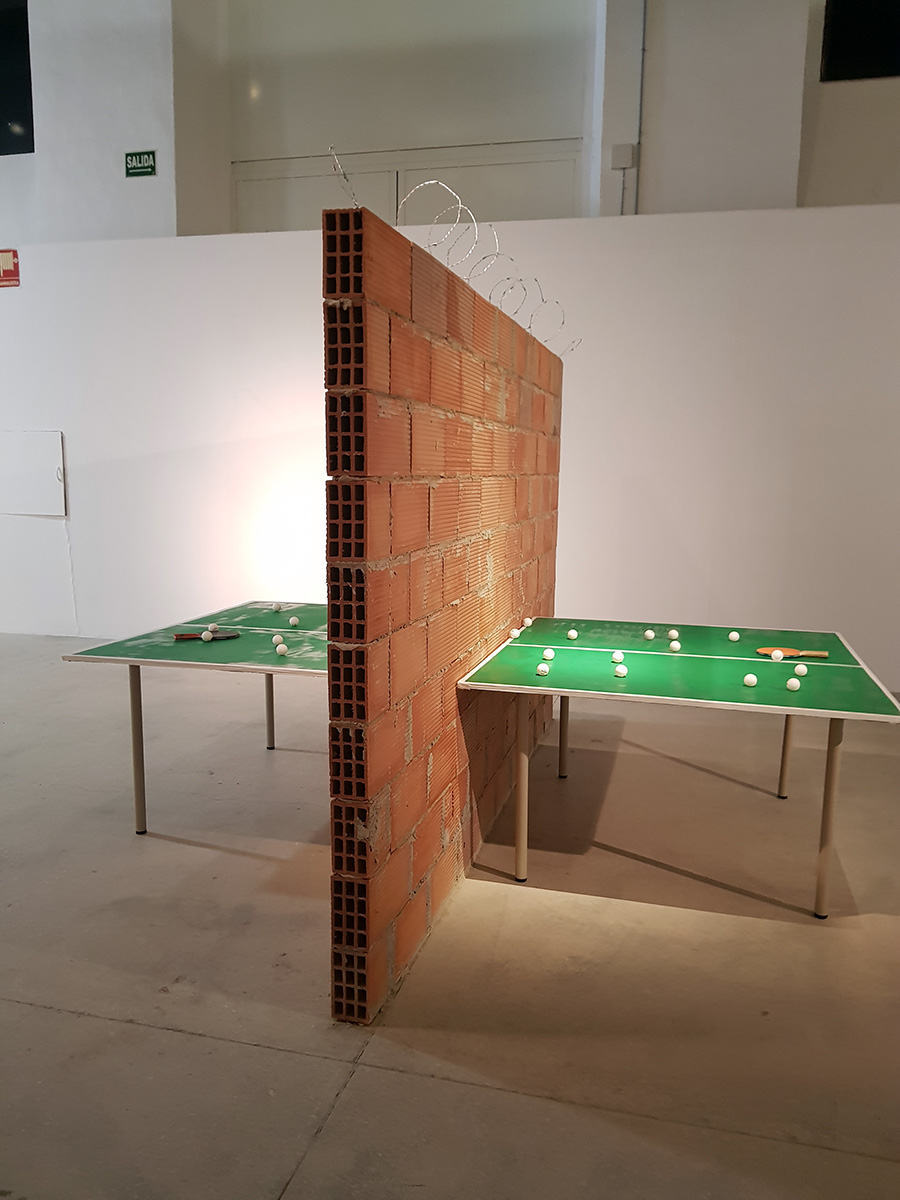
“Velvet-Strike is a mod of the first-person shooter video game Counter-Strike. The mod, developed by Anne-Marie Schleiner, Joan Leandre, and Brody Condon, adds “protest sprays” to the game’s existing graffiti function.”
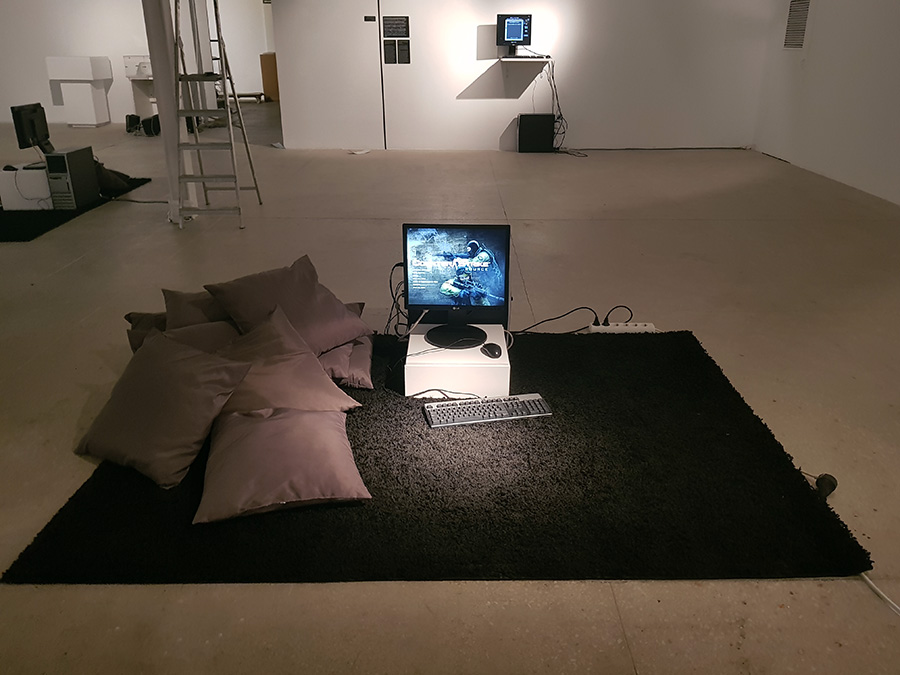
“Ladrillazo is a historical game that takes you to the real estate bubble of the first decade of the 21st century. There were days of wine and roses, an interpretation center in each town, an airport in each city, mortgages at 40 years, masons with minister salaries, Olympic dreams, AVEs and golf resorts.”
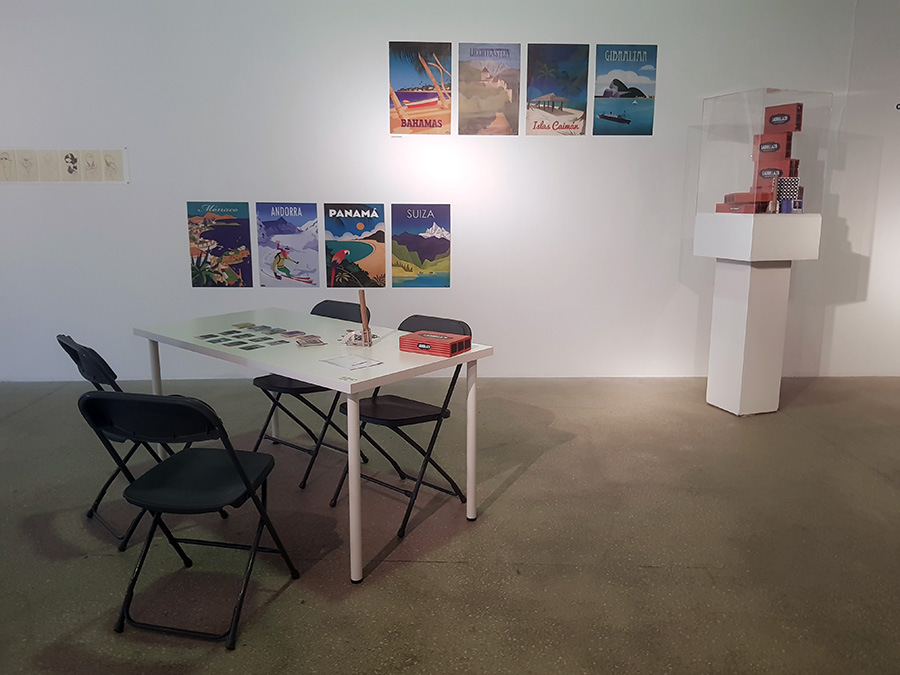
“Pac-Art is a version of the immensely popular Arcade video game Pac-Man. In this case, Pac-Art has transformed Pac-Man into an artist who has to devour famous works of art and flee from ghost-artists who threaten him.”
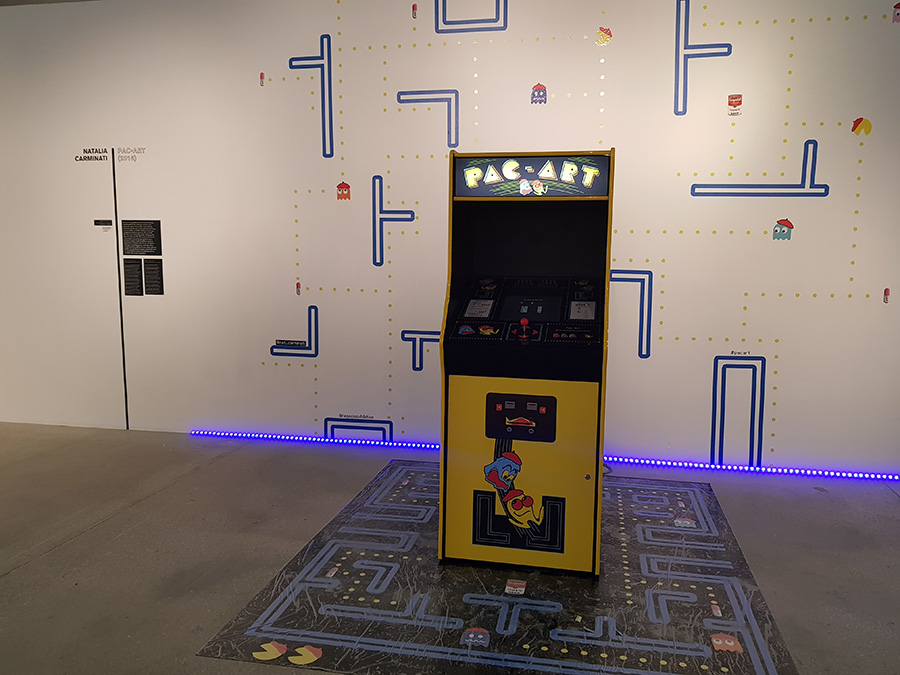
Ravalpoly by Alba Refulgente – a game of real estate speculation in Barcelona that re-contextualizes the game Monopoly.
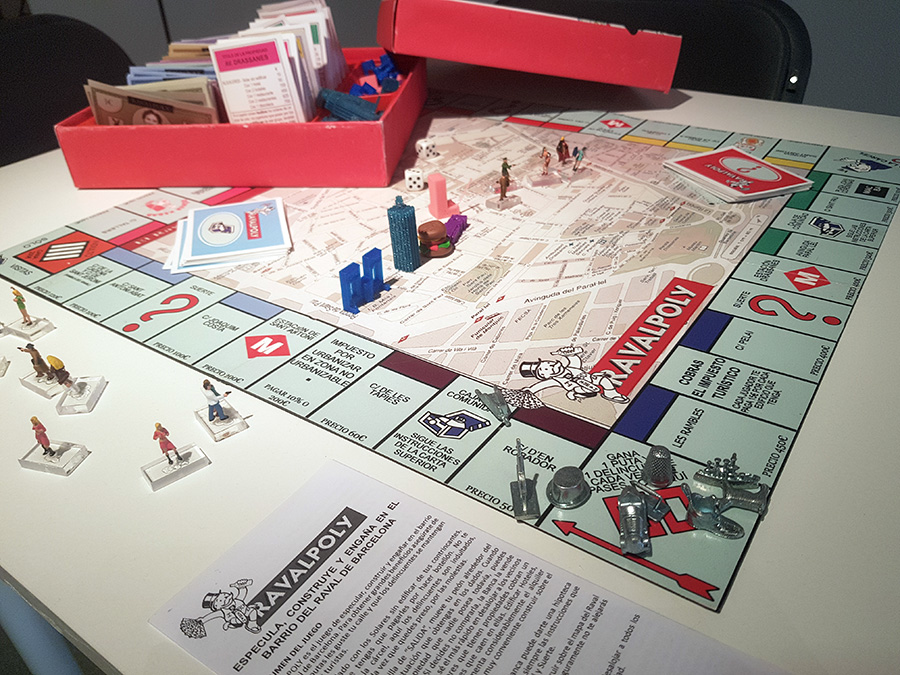
Visitors will have the opportunity to play Yoko Ono’s “White Chess.”
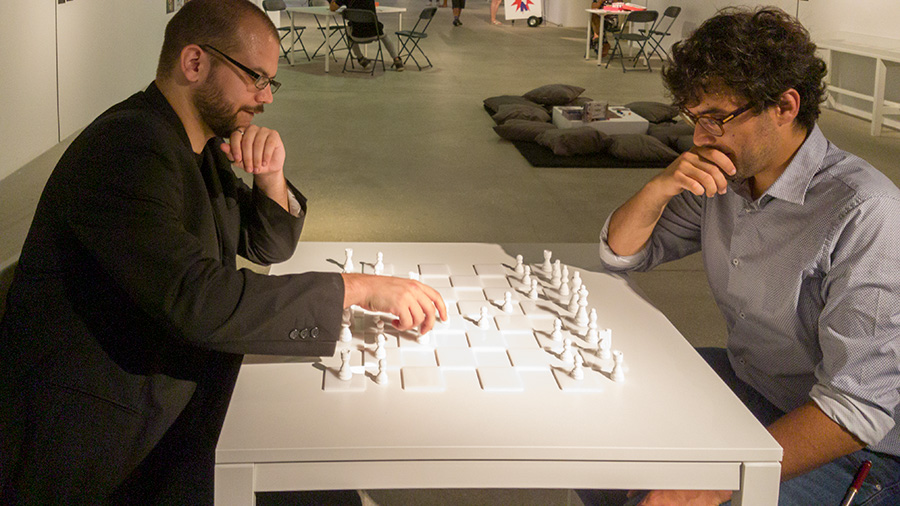
Many other artists and game makers are included in this exhibition, including Brenda Romero, Connor Monahan, Molleindustria, Richard Hofmeier, Jason Rohrer, Joan Priego amongst others. And one more image of VAGAMUNDO:
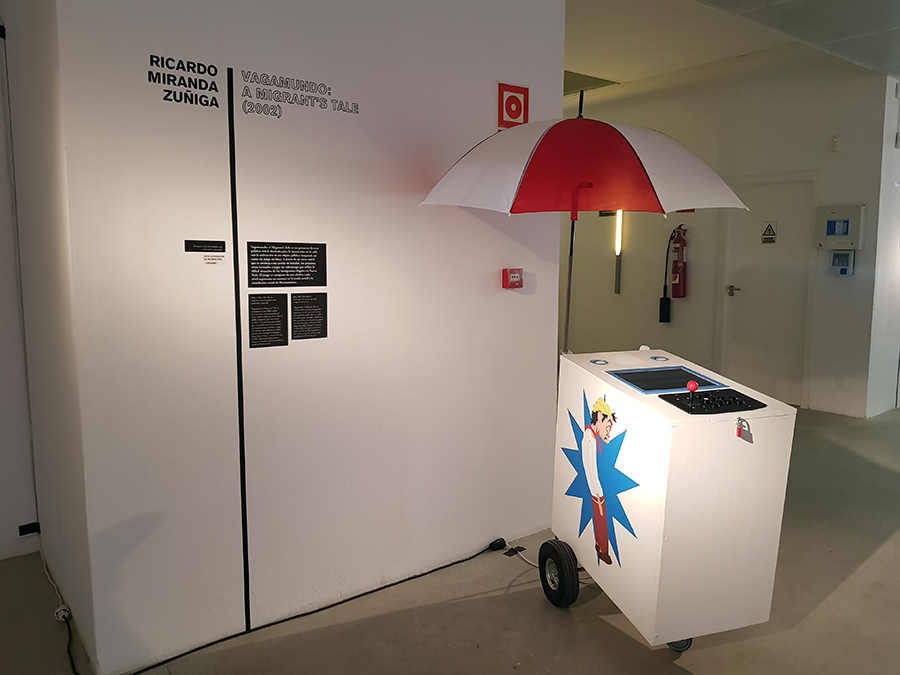
On View at Cuchifritos Gallery
Artist Antonia Pérez creates sculptures by weaving discarded plastic bags. She worked at the gallery during the exhibition.
This is the final weekend for the exhibition “Lettuce, Artichokes, Red Beets, Mangoes, Broccoli, Honey and Nutmeg: The Essex Street Market as Collaborator” at Cuchifritos Gallery located in the Essex Street Market. The exhibition curated by Nicolás Dumit Estévez Raful has been in the works for the past two years. The premise of the exhibition is for “six socially conscious artists to engage vendors, customers and the Market itself in their artistic processes as a means of co-generating experiences centered on the life that unfolds outside Cuchifritos Gallery, the art space of the Artist Alliance Inc”.
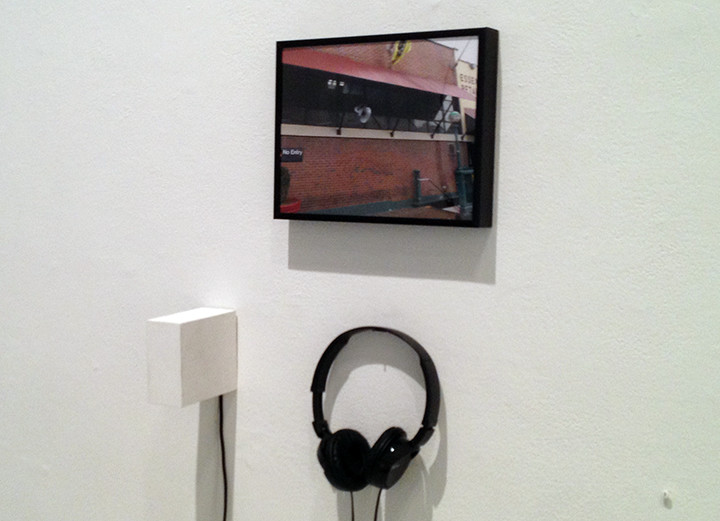
“Recetas y Gangas: The Essex Street Market Recordings” with mock up of originally proposed installation of bullhorn on the facade of the market
So in preparation for the exhibition, the artists came together with Jodi Waynberg the Executive Director of Artist Alliance as well as Nicolas to begin considering how the artists might work with the market. Jodi toured the artists through the market and introduced them to various vendors as well as the building manager and staff. Nearly all the artists attended a Vendors Association Meeting to present their projects and solicit collaboration.
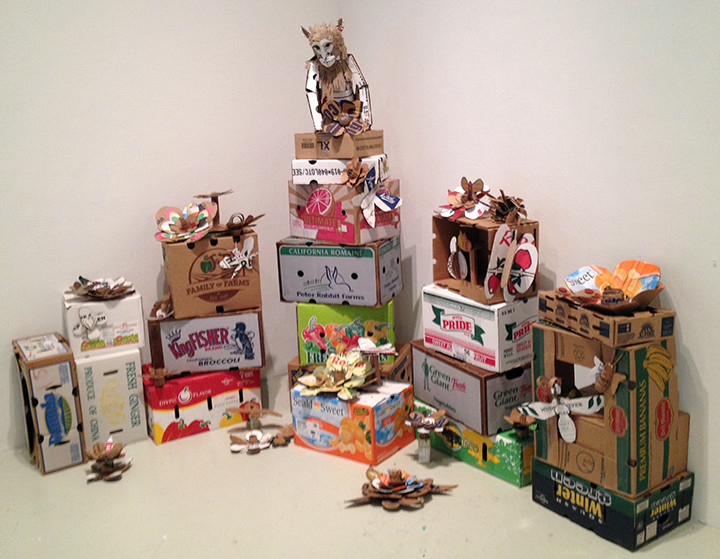
“Refuse Redo” a collaboration between Mary Ting and Lower East Side Girls Club/La Tiendita – sculptures made from market cardboard.
As one may imagine, the vendors are small business owners and workers. The market is the place that they go to for employment, not necessarily for cultural engagement. Many of the vendors are entirely preoccupied with maintaining their business and were no nonsense about artistic participation. If the artists did not approach with a brief and concrete plan for collaboration, there was little chance of any cooperation. A few vendors were excited at the prospect of creative engagement and happily collaborated. However in general, the ambitious projects envisioned by the artists needed to be simplified.
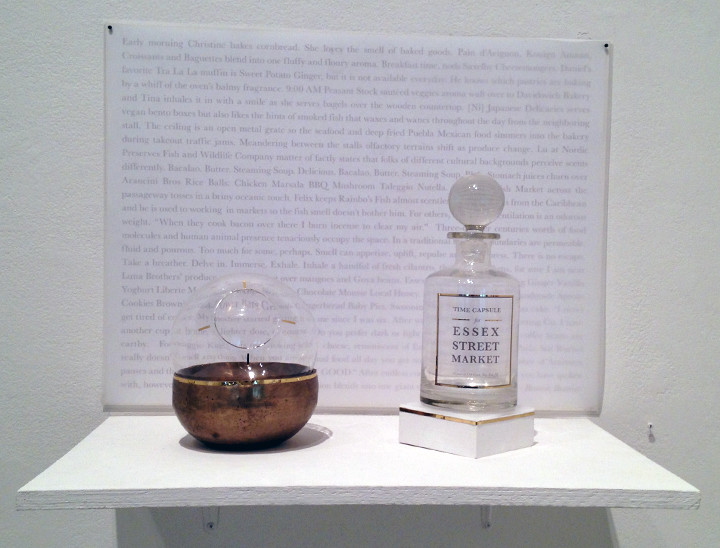
Scent and air time capsule of the Essex Street Market by Beatrice Glow.
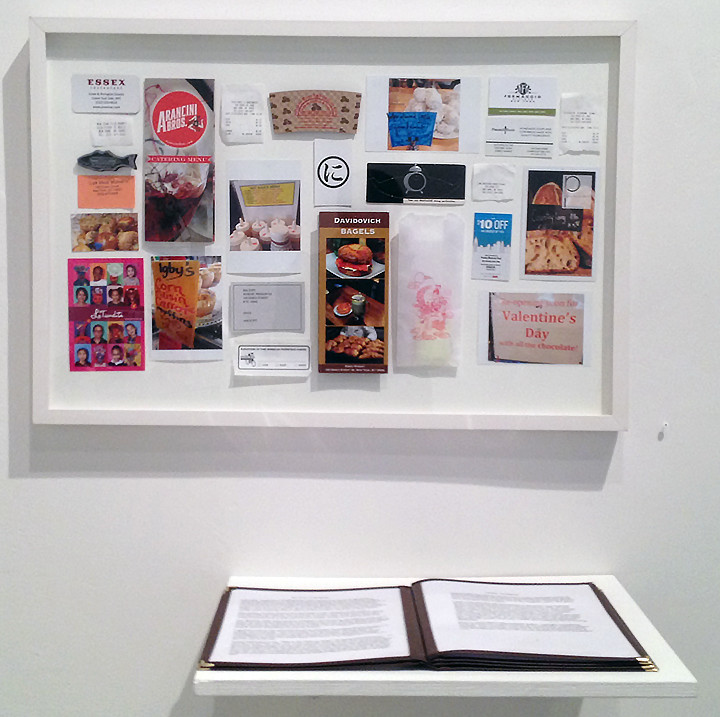
Market collection and journal by Inspector Collector Harley Spiller.
Laia Solé and Nicolás Dumit Estévez Raful employ the color green from the market to create a video montage that collapses the artists at work and the market at work.
For example, I wanted to create an audio montage of the vendors chanting or singing their goods and then to have that audio amplified onto the street via a bullhorn installed on the facade of the Essex Street Market. The concept was to have the interior of the market spill out onto the street as street markets commonly do in Latin America and Europe. Most of the vendors were not comfortable in singing their goods and the building management did not allow the installation of the bullhorn due to city ordinances regarding noise pollution (at least that was their excuse). When I was recording one of the vendors, a shopper approached me to tell me about recipes that she uses for a particular root. It then occurred to me that if vendors did not want to sing, perhaps they would share a recipe and the audio montage became primarily recordings of market recipes. As the piece would not be projected onto the street via a loudspeaker, I created a sandwich board with a speaker installed into it and wore the sandwich board on the street. In this way, the original concept of the piece was fully realized.
Each artist has her or his own story of how the work needed to be modified for the final exhibition. And in the end, this is the nature of collaboration.
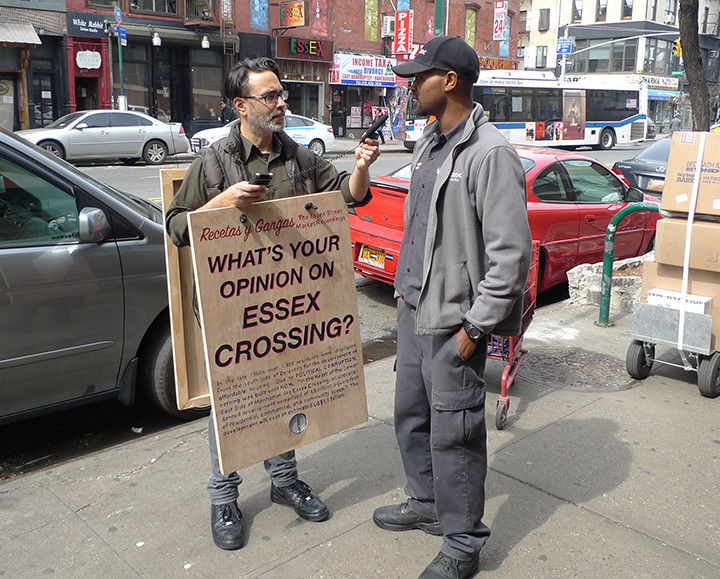
“Recetas y Gangas: The Essex Street Market Recordings” with mock up of originally proposed installation of bullhorn on the facade of the market
Nicolás Dumit Estévez Interviews Ricardo Miranda Zúñiga
 As part of the exhibition “PLAYING WITH FIRE: Political Interventions, Dissident Acts, and Mischievous Actions” at El Museo del Barrio several interviews were conducted with the artists concerning their practice. Below is the interview that the curator Nicolás Dumit Estévez conducted with me for the exhibition. The exhibition continues on view until February 7th.
As part of the exhibition “PLAYING WITH FIRE: Political Interventions, Dissident Acts, and Mischievous Actions” at El Museo del Barrio several interviews were conducted with the artists concerning their practice. Below is the interview that the curator Nicolás Dumit Estévez conducted with me for the exhibition. The exhibition continues on view until February 7th.
NDE: Can you talk about the use of firearms in On Transmitting Ideology?
RMZ: Through the amplification of mass media, ideological rhetoric is a powerful cultural weapon. I wanted to make as transparent as possible the power of ideological speech and its transmission through the media; mounting the radios on to the forms of AK47s and Uzis immediately triggers this link – the transmission of ideological speech is a political weapon.
NDE: I had the opportunity to see images of the performance of On Transmitting Ideology in Berlin, Germany. What were some of the reactions from passersby? My understanding is that people in the streets encountered you, as well as a small cadre of performers carrying wooden AK47s? How did you go about recruiting participants to your piece?
RMZ: The march was one act of a 24 hour sound performance titled “Moving Forest” that was commissioned for “transmediale.08: CONSPIRE…” an annual art and digital culture festival in Berlin. The performance and call for participants was circulated during the festival, so it was festival participants that volunteered to be part of the performance. The march of 20 participants was from Haus der Kulturen der Welt to the public park Siegessäule with a stop by the mayor’s home. My constant fear was that of authorities stoping us, but police merely looked at us with disinterest. Also most pedestrians merely paused to watch us, some asked what we were doing and when English speaking, we had them listen to the audio montage. People who did so, generally understood the work and were only surprised by the extremism spoken in the historically famous speeches.
NDE: There is a great deal of debate between those who advocate for guns and those who want to ban them . I am wondering how On Transmitting Ideology may or may not position itself in the context of this push and pull.
RMZ: The representation of the gun is to reflect the violent nature of ideology and if one is to listen to the audio montage, it capture extremism. I consider both violence and extremism as negative characteristics of society. The reading of the work that is most in line with my goal in creating the work is that we as a society need to move away from both weapons and ideological extremisms – political and religious.
NDE: What are your thoughts about the politization of aesthetics. It has come to my attention that, while it is fashionable to make “political” work, politics are not a hip subject in the art world?
RMZ: I have little interest in the art world. I’m much more interested in art that exists outside of the art world; art that engages people who are not seeking art and may function outside the gallery or museum. I’m interested in art that attempts to weave itself into the fiber of everyday culture while investigating, questioning and perhaps critiquing normative culture to stir self reflection. Much of the exchange in the art world is to decorate the homes of the wealthy or perhaps to serve as an investment for the wealthy. Perhaps for the art collector, investing in work that portrays current day politics is a bad long-term investment choice and not the best home decoration. If art world work is political, it needs to be sufficiently abstracted or undefined to function as a commodity object, so that any political potential has been muted.
NDE: Making political art work entails a big responsibility and a challenge as well. How can art that is politically-conscious live beyond the art world and effect change in society at large? And is this the role of the artist?
RMZ: This is a tough questions, because I don’t know how one would measure the effect of politically charged work upon others whom it may inspire to act. I believe that as long as the drive to create political art is sincere – that the artist is compelled to make political art due to first-hand experience of injustice, inequality, the misuse of power, it is not the role of the artist to effect change. The role of the artist is to capture and convey.
This interview is part of Crossfire, a project conceived and edited by Nicolás Dumit Estévez for El Museo del Barrio.
Interview with OBTRUSIV
Last Saturday, I met with Keith Estiler and Edgar De La Vega of OBTRUSIV MAG to discuss art. They’ve put the interview on their Art & Culture column, the article is titled – Pricking the Public. Here’s the video:
“portables” Video Documentation
Nicolás Spencer N, produced a video documenting the various projects on view as part of the exhibition “portables” curated by Ignacio Nieto for El Museo Nacional de Bellas Artes, Santiago Chile. The video is presented as a component of the exhibition since all of the projects are intended for the public space or for performance.